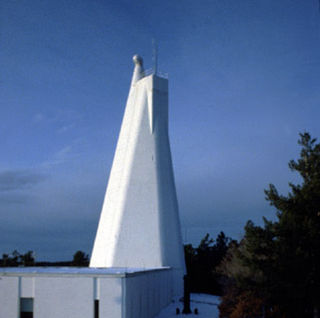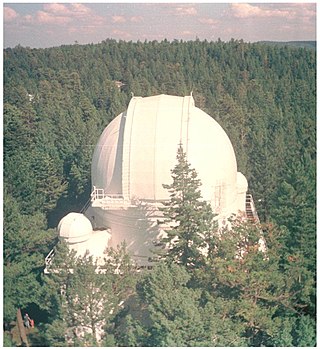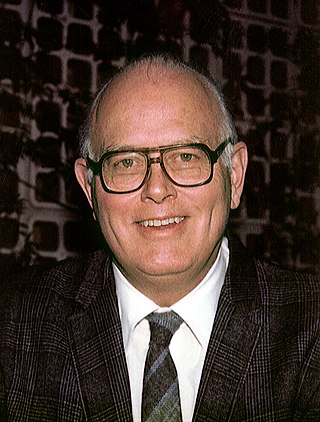Related Research Articles

The Kitt Peak National Observatory (KPNO) is a United States astronomical observatory located on Kitt Peak of the Quinlan Mountains in the Arizona-Sonoran Desert on the Tohono Oʼodham Nation, 88 kilometers (55 mi) west-southwest of Tucson, Arizona. With more than twenty optical and two radio telescopes, it is one of the largest gatherings of astronomical instruments in the Earth's northern hemisphere.

The Mount Wilson Observatory (MWO) is an astronomical observatory in Los Angeles County, California, United States. The MWO is located on Mount Wilson, a 5,710-foot (1,740-meter) peak in the San Gabriel Mountains near Pasadena, northeast of Los Angeles.

The Cerro Tololo Inter-American Observatory (CTIO) is an astronomical observatory located on the summit of Mt.Cerro Tololo in the Coquimbo Region of northern Chile, with additional facilities located on Mt. Cerro Pachón about 10 kilometres (6.2 mi) to the southeast. It is approximately 80 kilometres (50 mi) east of La Serena, where support facilities are located. The site was identified by a team of scientists from Chile and the United States in 1959, and it was selected in 1962. Construction began in 1963 and regular astronomical observations commenced in 1965. Construction of large buildings on Cerro Tololo ended with the completion of the Víctor Blanco Telescope in 1974, but smaller facilities have been built since then. Cerro Pachón is still under development, with two large telescopes inaugurated since 2000, and one in the final stages of construction as of 2023

The Association of Universities for Research in Astronomy (AURA) is a consortium of universities and other institutions that operates astronomical observatories and telescopes.

The Haleakalā Observatory, also known as the Haleakalā High Altitude Observatory Site, is Hawaii's first astronomical research observatory. It is located on the island of Maui and is owned by the Institute for Astronomy of the University of Hawaiʻi, which operates some of the facilities on the site and leases portions to other organizations. Tenants include the Air Force Research Laboratory (AFRL) and the Las Cumbres Observatory Global Telescope Network (LCOGTN). At over 3,050 meters (10,010 ft) in altitude, the summit of Haleakalā is above one third of the Earths's troposphere and has excellent astronomical seeing conditions.

Teide Observatory, IAU code 954, is an astronomical observatory on Mount Teide at 2,390 metres (7,840 ft), located on Tenerife, Spain. It has been operated by the Instituto de Astrofísica de Canarias since its inauguration in 1964. It became one of the first major international observatories, attracting telescopes from different countries around the world because of the good astronomical seeing conditions. Later, the emphasis for optical telescopes shifted more towards Roque de los Muchachos Observatory on La Palma.
Solar physics is the branch of astrophysics that specializes in the study of the Sun. It intersects with many disciplines of pure physics and astrophysics.

The Dunn Solar Telescope also known as the Richard B. Dunn Solar Telescope is a unique vertical-axis solar telescope, in Sunspot, New Mexico located at Sacramento Peak, New Mexico. It is the main telescope at the Sunspot Solar Observatory, operated by New Mexico State University in partnership with the National Solar Observatory through funding by the National Science Foundation, the state of New Mexico and private funds from other partners. The Dunn Solar Telescope specializes in high-resolution imaging and spectroscopy to help astrophysicists worldwide obtain a better understanding of how the Sun affects the Earth. Completed in 1969, it was upgraded with high-order adaptive optics in 2004 and remains a highly versatile astrophysical observatory which serves as an important test platform for developing new instrumentation and technologies. The Dunn Solar Telescope, located in Sunspot, New Mexico, is a vertical-axis solar telescope that specializes in high-resolution imaging and spectroscopy. It was completed in 1969 and received a significant upgrade with high-order adaptive optics in 2004.

Big Bear Solar Observatory (BBSO) is a university-based solar observatory in the United States. It is operated by New Jersey Institute of Technology (NJIT). BBSO has a 1.6-meter (5.2 ft) clear aperture Goode Solar Telescope (GST), which has no obscuration in the optical train. BBSO is located on the north side of Big Bear Lake in the San Bernardino Mountains of southwestern San Bernardino County, California, U.S., approximately 120 kilometers (75 mi) east of downtown Los Angeles. The telescopes and instruments at the observatory are designed and employed specifically for studying the activities and phenomena of the Sun.

A solar telescope is a special purpose telescope used to observe the Sun. Solar telescopes usually detect light with wavelengths in, or not far outside, the visible spectrum. Obsolete names for Sun telescopes include heliograph and photoheliograph.

The Daniel K. Inouye Solar Telescope (DKIST) is a scientific facility for studies of the Sun at Haleakala Observatory on the Hawaiian island of Maui. Known as the Advanced Technology Solar Telescope (ATST) until 2013, it was named after Daniel K. Inouye, a US Senator for Hawaii. It is the world's largest solar telescope, with a 4-meter aperture. The DKIST is funded by National Science Foundation and managed by the National Solar Observatory. The total project cost is $344.13 million. It is a collaboration of numerous research institutions. Some test images were released in January 2020. The end of construction and transition into scientific observations was announced in November 2021.
The High Altitude Observatory (HAO) is a laboratory of the US National Center for Atmospheric Research (NCAR). HAO operates the Mauna Loa Solar Observatory on Hawaii and a research institute in Boulder, Colorado.
The Solar Observing Optical Network (SOON) consists of three U.S. Air Force (USAF) Air Force Weather Agency (AFWA) solar observatories. AFWA operates a solar telescope at each site to monitor solar active regions at optical wavelengths. The National Geophysical Data Center (NGDC) archives histograms of intensity versus area every minute for the active regions. It also archives magnetograms of the magnetic field structure and tachograms of plasma velocities on an irregular schedule.

Aryabhatta Research Institute of Observational Sciences (ARIES) is a research institute in Nainital, Kumaon, India which specializes in astronomy, solar physics, astrophysics and atmospheric science. It is an autonomous body under the Department of Science and Technology, Government of India. The institute is situated at Manora Peak (elevation 1,951 m or 6,401 ft), about 9 kilometres (5.6 mi) from Nainital, headquarters of Kumaon division.

Cloudcroft Observatory, is an astronomical observatory located in the Lincoln National Forest near Cloudcroft, New Mexico, approximately 23 kilometers (14 mi) northeast of Alamogordo. It is owned by the Tzec Maun Foundation, a private astronomical organization.

Charles Mattias ("Matt") Mountain is currently the President of the Association of Universities for Research in Astronomy (AURA) which designs, builds, and operates telescopes and observatories for the National Science Foundation (NSF) and the National Aeronautics and Space Administration (NASA). AURA's NASA center is the Space Telescope Science Institute (STScI), responsible for the science mission for the Hubble Space Telescope, the science and operations for the James Webb Space Telescope, and the MAST data archive. AURA's NSF centers are Gemini Observatory, the National Optical Astronomy Observatory (NOAO), and the National Solar Observatory (NSO). Dr. Mountain and AURA are also responsible for the NSF construction projects: the Daniel K. Inouye Solar Telescope (DKIST) on Haleakalā, Hawaii and the Large Synoptic Survey Telescope (LSST) on Cerro Pachón in Chile.
John Wainwright Evans was an American solar astronomer born in New York City. He spent much of his career studying the sun and working with optics both of which earned him awards. The Evans Solar Facility at Sacramento Peak was named after him. Evans died in a murder–suicide with his wife in 1999.
The Sunspot Solar Observatory (SSO) is an astronomical observatory designed for the study of the Sun. The observatory is operated by New Mexico State University (NMSU) and the U.S. National Solar Observatory (NSO). It is split between operations at the telescope facility at Sunspot, New Mexico, and data and management at the Department of Astronomy at New Mexico State University. The Sunspot telescope facility is in the Sacramento Mountains, approximately 18 miles (29 km) south of Cloudcroft. Access to the facility telescopes and grounds are open for to the public for guided tours. It is funded by the National Science Foundation in partnership with the state of New Mexico.

Synoptic Optical Long-term Investigations of the Sun (SOLIS) is a synoptic facility for solar observations over a long time frame that is funded by the National Science Foundation (NSF) and designed and built by the National Solar Observatory (NSO). It is operated by the NSO Integrated Synoptic Program (NISP). SOLIS is a single set of three instruments mounted on a common observing platform. The instruments are the 50 cm aperture Vector Spectromagnetograph (VSM), the 8 mm aperture Integrated Sunlight Spectrometer (ISS), and the 14 cm aperture Full-Disk Patrol (FDP). The VSM telescope is a quasi-Ritchey-Chretien design with a primary mirror operating at f/1.6. The ~ 400 W of solar light from the primary is reflected by a secondary mirror fabricated from a single silicon crystal. The final f/6.6 full-disk solar image is focused on a spectrograph slit that is cooled by a flow of chilled water-propylene glycol solution. The mirrors are coated with protected silver. To improve the internal seeing, the VSM is sealed by 74 cm diameter, 6 mm thick fused silica window. Originally, it was filled with helium at about ambient pressure and temperature. In 2014, helium was replaced by nitrogen due to the increasing cost of helium. Due to this change, the image sharpness was slightly degraded.

Richard Brandner Dunn was an American solar physicist and astronomer who was a pioneer in solar physics. He is known for his designs of solar telescopes and their instruments, most notably the Richard B. Dunn Solar Telescope. At the time of his death he was astronomer emeritus of the National Solar Observatory.
References
- 1 2 Leverington, David (2013). Encyclopedia of the History of Astronomy and Astrophysics. Cambridge: Cambridge University Press. p. 287. ISBN 978-0-521-89994-9.
- ↑ Zirker, J. B. (1998). "The Sacramento Peak Observatory". Solar Physics. No. 182. pp. 1–19.
- ↑ Klotz, Irene. "Citizen scientists will take to the field for U.S. eclipse". U.S. Retrieved 2018-07-06.